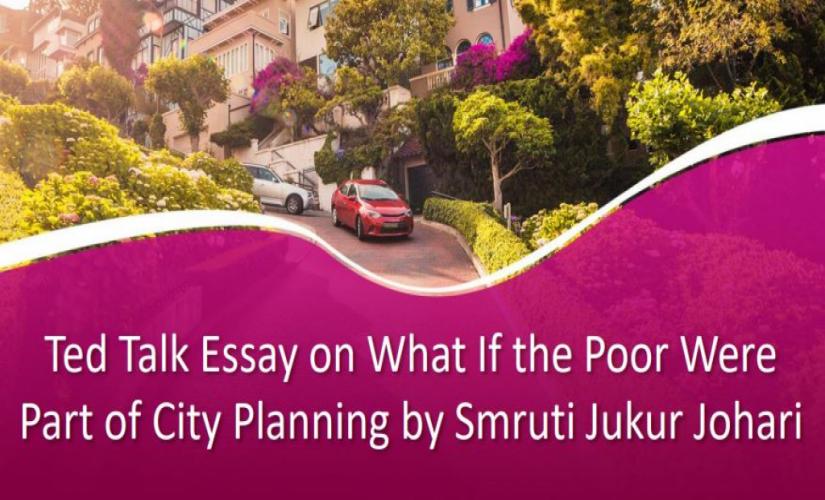City planners and management are in charge of urban city planning. By considering this Ted Talk essay on “What If the Poor Were Part of City Planning” by Smruti Jukur Johari, the planners are in charge of designing the city and the slums, despite them not knowing what is best for slum dwellers. Therefore, the poor in the slums should be allowed to choose what is best for them, and their choices should be respected, and that way, an all-inclusive city will be built.
The Role of the Poor
The video is an expression of the role of the poor in urban cities. What is exclusive is how the poor in the slums have been set aside by the others (Johari 0:30- 0:45). Besides, they have to live in informal settlements and slums where they are prone to eviction, poor sanitation, and poor infrastructure. Although they go through such conditions, they are the laborers that make the city function normally.

The Slums Network
Due to harsh realities and living conditions, some slums have started self-help groups that seek to eradicate the threats they face in the slums. Basically, the slums network’s primary purpose is to address issues such as sanitation, infrastructure, demolitions, and evictions (Johari 10:30- 11:00). In this case, the poor inhabiting the wastelands that the city had abandoned have resulted in the land gaining value to the extent of attracting developers. Hence, the developers evict them to vertical houses that cause them health problems due to poor lighting.
Suggestion
Some suggestions would be for the cities management to address the issues slum dwellers experience. In turn, the main problems in the slums are infrastructure, which includes roadways and inexpensive housing and essential help such as water and public cleanliness (Mahavir et al. 399). Apart from addressing the problems, they should include the residents of the slums in the decisions made about the infrastructure and sanitation. Hence, the reason being they are the ones living in those conditions and know what is best for them.
The Plight of Poor Slum Residents
The author of the video was convincing. For example, the plight of poor slum residents was addressed and how they suffer in the hands of those in power and how they face harsh conditions and still go to work daily to grow the economy (Johari 3:08: 3:20). Basically, the author has shown how they have grouped themselves in a bid to address the problems of infrastructure and essential services. Moreover, a group from Mukuru in Nairobi was successful in convincing the city government to provide the slum with water, roads, housing, and not to live in fear of eviction.
Bias
The bias in the video includes that the author has not explained the sabotage that happens as a result of slum residents. In this case, some governments have been supportive of the slums by providing them with the appropriate services such as water, lighting, among others. Hence, the desperation in the slums has led to the services being vandalized and sabotaged by the residents.
Proposal
Slum-dwellers need to cleanse their immoral trait and create proper and reliable relations with city management and policymakers. In this case, unethical characteristics are as a result of the conditions present in the slums (Corburn 147). Also, immoral traits include violence, destruction, stealing, and polluting the environment. Hence, the presence of ethical behavior in the slum will result in the city management’s willingness to develop the slums and bring the required services.
The Need to Communicate
City management and policymakers are crucial in the decisions made about the slums. For example, they are ones who decide on the developments and the type of infrastructure in the favelas (Fainstein par. 1). Besides, a strong relationship with the policymaker and city management will ensure that the slum dwellers are involved in the designs of the infrastructure to be put up in the slum. Thus, that is a positive thing since they will make sure the houses built are according to the plan that favors them.
Conclusion
In conclusion, slum-dwellers choices are crucial in the building of an all-inclusive city. Basically, respecting their choices and including them in city planning decisions will eliminate the rift between favelas and the city. Also, a city will empower the poor to pursue their aspirations without the setback of living conditions.
Works Cited
Corburn, Jason. Healthy City Planning from Neighborhood to National Health Equity. Routledge, 2013.
Fainstein, Susan S. “Urban Form.” Encyclopedia Britannica, 2019, www.britannica.com/topic/urban-planning/Urban-form#ref10809.
Johari, Smruti J. “What If the Poor Were Part of City Planning.” TED, 2019, www.ted.com/talks/smruti_jukur_johari_what_if_the_poor_were_part_of_city_planning.
Mahavir, Ron, et al. “The Study of Slums as Social and Physical Constructs: Challenges and Emerging Research Opportunities.” Regional Studies, Regional Science, vol. 3, no. 1, 2016, pp. 399–419, doi:10.1080/21681376.2016.1229130.


